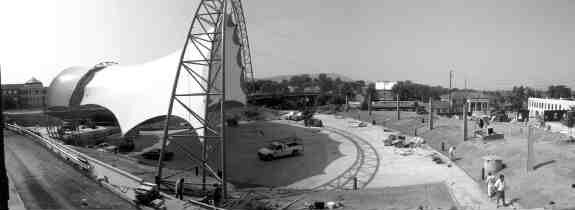Pavilion patrimony: World's largest lobster trap
Charlottesville's new Pavilion is days away from officially opening. We will all marvel at the increased capacity, the sheer mass of canvas and truss, and the aching ballads of Loretta Lynn on July 30. But, marvel too at our new monument to impermanence and wastefulness. To be sure, this is a downtown anchor, but it's also a paper lion whose stature is impressive, but impotent.
When new civil facilities are necessitated by the terms of a community– an aging population, an increasingly mobile population, or simply a growing population– what the art critic Robert Hughes called "the shock of the new" is received with both consternation and applause. The mission of the now-defunct Charlottesville Downtown Foundation was to bring folks Downtown at a time when that was not happening– and it succeeded in the old amphitheater.
Both detractors and advocates of Coran Capshaw, the Pavilion's developer, might be able to agree on the fact that the new Charlottesville Pavilion will accommodate larger acts for larger groups of people. But while the form may fulfill its function, it's the wrong thing for the site.
Two criteria for judging an outdoor concert venue should be how well it will function and the "pleasure principle" of its form. But when you build in the historic part of a city, context matters as much as function and form. If we think of Form (as an ideal) for this city and these times, it exists when it is accountable, insightful, and sustains the way we live.
What can be said about the Pavilion is that it will be a structure for our disposable times. The fact that the pavilion's canvas covering will reputedly have to be replaced every seven years is self-consciously impermanent and wasteful. Winds during a July 13 storm destroyed the canvas cover over the seating area and left the thing half-built. While the destroyed canvas will eventually be replaced, there are surely more storms to come.
Why are we putting a junkable structure on this site? This site: one of the most prominent in Charlottesville, part of the civic core (City Hall, the police station), the termination of a promenade, the gateway to Belmont, and part a historic downtown area. So why is this site being insulted by an enormous lobster trap? Even Claes Oldenburg, an artist who made a career out of enlarging everyday objects to an enormous scale, had more sense than this. He never would have done this to a historic site.
If the function of the pavilion itself is to accommodate larger crowds, the function of the site should be in service of Downtown. The nature of the old amphitheater and grounds was wholly civic: a public space for citizens to recreate freely– both in the economic and democratic sense of the word. The Pavilion will remain free for fans of Fridays After 5, but it will also be a for-profit concert venue for 40 days of the year. That means 40 days of prime summer enjoyment will be stolen from park-goers. In addition, the grassy area will be reduced to a crescent-shaped swath in order to make room for removable seating.
Of course, the answer to "Who's profiting?" is: not the city and certainly not the citizens. Oh, wait– Capshaw is– at the expense of anyone who ever enjoyed eating lunch, playing in the grass, or the festival-feel of Fridays on that site. In the case of the Charlottesville Pavilion, the old adage applies: Just because you can do something doesn't mean you should.
In Charlottesville, like other cities, what gets built to accommodate a changing population is not always what looks good. Money tends to talk and walk far louder and more expediently than common sense or taste. Be that as it may, the last thing Downtown needed was another cheap-looking behemoth to "anchor" its other end.

PHOTO BY HAWES SPENCR